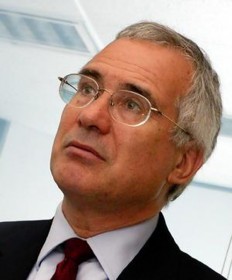Nicholas Stern is Chair of the Grantham Research Institute on Climate Change and the Environment and Professor of Economics and Government at the London School of Economics and Political Science, and a member of the UK House of Lords. He was formerly head of the UK Government Economic Service and chief economist at the World Bank.
LONDON – The United Nations climate change conference, to be held in Copenhagen this December, should provide the climax to two years of international negotiations over a new global treaty aimed at addressing the causes and consequences of greenhouse-gas emissions.
A global deal on climate change is urgently needed. Concentrations of carbon dioxide and other greenhouse gases in the atmosphere have reached 435 parts per million (ppm) of CO2-equivalent, compared with about 280 ppm before industrialization in the nineteenth century.
If we continue with business-as-usual emissions from activities such as burning fossil fuels and cutting down forests, concentrations could reach 750 ppm by the end of the century. Should that happen, the probable rise in global average temperature relative to pre-industrial times will be 5˚C or more.
It has been more than 30 million years since the earth’s temperature was that high. The human species, which has been around for no more than 200,000 years, would have to deal with a more hostile physical environment than it has ever experienced. Floods and droughts would become more intense and global sea levels would be several metres higher, severely disrupting lives and livelihoods, and causing massive population movements and inevitable conflict around the world. Some parts of the world would be under water; other parts would become deserts.
Developing countries recognize and are angered by the inequity of the current situation. Current greenhouse-gas levels are largely due to industrialization in the developed world since the nineteenth century. Yet developing countries are the most vulnerable to the consequences of climate change, which threaten the economic growth that is necessary to overcome poverty. At the same time, emissions cannot be reduced at the extent required without the central contribution of the developing world.
Climate change and poverty, the two defining challenges of this century, must be tackled together. If we fail on one, we will fail on the other. The task facing the world is to meet the environment’s “carbon constraints” while creating the growth necessary to raise living standards for the poor.
To avoid the severe risks that would result from a rise in global average temperature of more than 2˚C, we must get atmospheric concentrations below 450 ppm. This will require a cut in annual global emissions from about 50 gigatonnes of CO2-equivalent today to below 35 gigatonnes in 2030, and less than 20 gigatonnes by 2050.
Today, per-capita annual emissions in the European Union are 12 tonnes, and 23.6 tonnes in the United States, compared to six tons for China and 1.7 tons for India. As the projections for 2050 suggest that the world’s population will be about nine billion, annual per-capita emissions must be reduced to approximately two tons of CO2-equivalent, on average, if the global annual total is to be less than 20 gigatonnes.
Most developed countries are targeting reductions in annual emissions of at least 80% – relative to levels in 1990 – by 2050. If they are to convince developing countries that the 2050 goal is credible, they must be both ambitious and realistic about the domestic political challenges they face in adopting and implementing demanding targets for 2020, 2030, and 2040.
Developing countries need substantial help and support from rich nations in order to implement their plans for low-carbon economic growth, and to adapt to the effects of climate change that are now inevitable over the next few decades. Developed countries should also provide strong support for measures to halt deforestation in developing countries, and for reducing emissions substantially, quickly, and at reasonable cost.
Based on recent estimates of the developing world’s extra requests as a result of climate change, rich countries should be providing annual financial support – in addition to existing foreign-aid commitments– of about $100 billion for adaptation and $100 billion for mitigation by the early 2020s. Some of the latter can come through carbon market. Rich countries must also demonstrate that low-carbon growth is possible by investing in new technologies, which should be shared with developing countries to boost their mitigation efforts.
We are already seeing extraordinary innovation by the private sector, which will drive the transition towards a low-carbon global economy. Investments in energy efficiency and low-carbon technologies could also pull the global economy out of its economic slowdown over the next couple of years. More importantly, in driving the transition to low-carbon growth, these technologies could create the most dynamic and innovative period in economic history, surpassing that of the introduction of railways, electricity grids, or the internet.
There is no real alternative. High-carbon growth is doomed, crippled by high prices for fossil fuels and killed off by the hostile physical environment that climate change will create. Low-carbon growth will be more energy-secure, cleaner, quieter, safer and more bio-diverse.
We should learn from the financial crisis that if risks are ignored, the eventual consequences are inevitably worse. If we do not start to combat the flow of greenhouse-gas emissions now, the stock in the atmosphere will continue to grow, making future action more difficult and costly. Other public expenditure can be postponed, but delaying climate-change measures is a high-risk, high-cost option.
Climate change poses a profound threat to our economic future, while low-carbon growth promises decades of increased prosperity. The choice in Copenhagen will be stark, and the stakes could not be higher. We know what we must do, and we can do it.
Copyright: Project Syndicate, 2009.
www.project-syndicate.org






